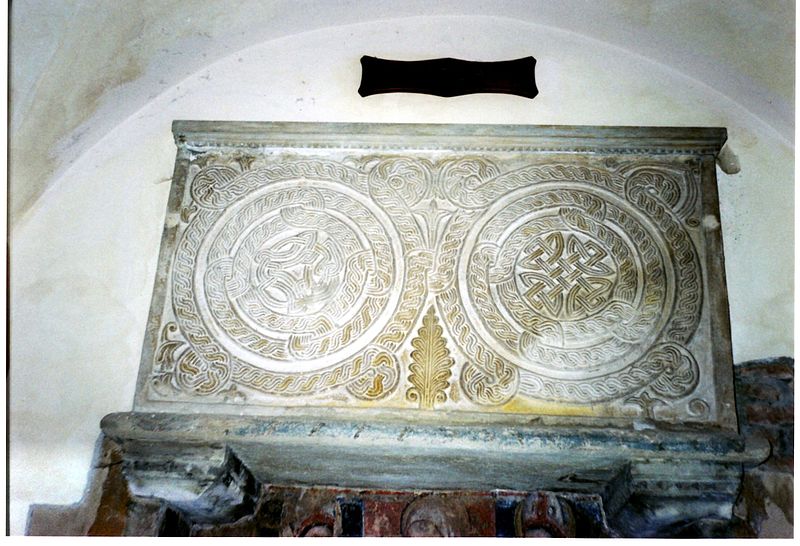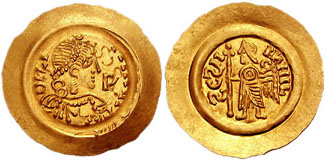|
Cumianus
Cumianus ( 641 – 736) was an Irish monk who became abbot of San Colombano di Bobbio around 715. He left Ireland as an old man. The intricately carved lid of his sarcophagus, containing a lengthy epitaph, was made by one Master John and commissioned by King Liutprand, King of the Lombards. The inscription on the tomb reads as follows; it is written in rhythmic hexameters, a kind of hexameter in which word accent is taken into account rather than syllable length:Thurneysen, R. (1887) ''Zeitschr. f. rom. Phil. XI.''; p. 316. : : : : : : : : : : : : : : : : :"Here lie the sacred limbs of Cumian; :whose soul, entering heaven, rejoices with the angels. :He was great in dignity, nobility, and beauty. :Ireland sent him as an old man to the lands of Italy: :located in Bobbio, constrained by love of the Lord, :where, by preserving the teaching of the venerable Columban, :keeping watch, fasting, tireless, constantly praying, :for four olympiads An olympiad ( el, Ὀλυμπιάς ... [...More Info...] [...Related Items...] OR: [Wikipedia] [Google] [Baidu] |
Bobbio Abbey
Bobbio Abbey (Italian: ''Abbazia di San Colombano'') is a monastery founded by Irish Saint Columbanus in 614, around which later grew up the town of Bobbio, in the province of Piacenza, Emilia-Romagna, Italy. It is dedicated to Saint Columbanus. It was famous as a centre of resistance to Arianism and as one of the greatest libraries in the Middle Ages. The abbey was dissolved under the French administration in 1803, although many of the buildings remain in other uses. History Foundation The background to the foundation of the abbey was the Lombard invasion of Italy in 568. The Lombard king Agilulf married the devout Roman Catholic Theodelinda in 590 and under her influence and that of the Irish missionary Columbanus, he was persuaded to accept conversion to Christianity. As a base for the conversion of the Lombard people Agilulf gave Columbanus a ruined church and wasted lands known as Ebovium, which, before the Lombards seized them, had formed part of the lands of the papacy. Co ... [...More Info...] [...Related Items...] OR: [Wikipedia] [Google] [Baidu] |
Latin Rhythmic Hexameter
The Latin rhythmic hexameter or accentual hexameter is a kind of Latin dactylic hexameter which arose in the Middle Ages alongside the metrical kind. The rhythmic hexameter did not scan correctly according to the rules of classical prosody; instead it imitated the approximate sound of a typical metrical hexameter by having roughly the same number of syllables and putting word accents in approximately the same places in the line. The rhythmic hexameter flourished between the 3rd and 9th century A.D. The earliest examples come from what is now Tunisia in north Africa. One poet to use it for literary compositions was Commodian, who is thought to have lived in North Africa in the 3rd century AD. Other examples come from Portugal, Spain, Lombardy in northern Italy, and southern France. Several examples are found on tombstones, but there is also an anonymous Christian work of the 6th or 7th century called , and a book of riddles of the 8th century. Over the centuries the style of the rhy ... [...More Info...] [...Related Items...] OR: [Wikipedia] [Google] [Baidu] |
Irish People
The Irish ( ga, Muintir na hÉireann or ''Na hÉireannaigh'') are an ethnic group and nation native to the island of Ireland, who share a common history and culture. There have been humans in Ireland for about 33,000 years, and it has been continually inhabited for more than 10,000 years (see Prehistoric Ireland). For most of Ireland's recorded history, the Irish have been primarily a Gaelic people (see Gaelic Ireland). From the 9th century, small numbers of Vikings settled in Ireland, becoming the Norse-Gaels. Anglo-Normans also conquered parts of Ireland in the 12th century, while England's 16th/17th century conquest and colonisation of Ireland brought many English and Lowland Scots to parts of the island, especially the north. Today, Ireland is made up of the Republic of Ireland (officially called Ireland) and Northern Ireland (a part of the United Kingdom). The people of Northern Ireland hold various national identities including British, Irish, Northern Irish or som ... [...More Info...] [...Related Items...] OR: [Wikipedia] [Google] [Baidu] |
Liutprand, King Of The Lombards
Liutprand was the king of the Lombards from 712 to 744 and is chiefly remembered for his multiple phases of law-giving, in fifteen separate sessions from 713 to 735 inclusive, and his long reign, which brought him into a series of conflicts, mostly successful, with most of Italy. He is often regarded as the most successful Lombard monarch, notable for the Donation of Sutri in 728, which was the first accolade of sovereign territory to the Papacy. Early life Liutprand's life began inauspiciously. His father was driven to exile among the Bavarians, his older brother Sigipert was blinded by Aripert II, king of the Lombards, and his mother Theodarada and sister Aurona were mutilated (their noses and ears were cut off). Liutprand was spared only because his youth made him appear harmless, described as adolescens in Paul the Deacon's ''Historia Langobardorum'' (Book VI, xxii), suggesting that he was 'probably older than 19 but still in his twenties'. He was released from Aripert II's ... [...More Info...] [...Related Items...] OR: [Wikipedia] [Google] [Baidu] |
Columbanus
Columbanus ( ga, Columbán; 543 – 21 November 615) was an Irish missionary notable for founding a number of monasteries after 590 in the Frankish and Lombard kingdoms, most notably Luxeuil Abbey in present-day France and Bobbio Abbey in present-day Italy. Columbanus taught an Irish monastic rule and penitential practices for those repenting of sins, which emphasised private confession to a priest, followed by penances levied by the priest in reparation for the sins. Columbanus is one of the earliest identifiable Hiberno-Latin writers. Sources Most of what we know about Columbanus is based on Columbanus' own works (as far as they have been preserved) and Jonas of Susa's ''Vita Columbani'' (''Life of Columbanus''), which was written between 639 and 641. Jonas entered Bobbio after Columbanus' death but relied on reports of monks who still knew Columbanus. A description of miracles of Columbanus written by an anonymous monk of Bobbio is of much later date.O'Hara, Alexander, ... [...More Info...] [...Related Items...] OR: [Wikipedia] [Google] [Baidu] |
Olympiads
An olympiad ( el, Ὀλυμπιάς, ''Olympiás'') is a period of four years, particularly those associated with the ancient and modern Olympic Games. Although the ancient Olympics were established during Greece's Archaic Era, it was not until Hippias that a consistent list was established and not until Ephorus in the Hellenistic period that the first recorded Olympic contest was used as a calendar epoch. Ancient authors agreed that other Olympics had been held before the race won by Coroebus but disagreed on how many; the convention was established to place Coroebus's victory at a time equivalent to the summer of 776 in the Gregorian calendar and to treat it as Year 1 of Olympiad 1. Olympiad 2 began with the next games in the summer of 772 . Thus, for N less than 195, Olympiad N is reckoned as starting in the year 780-(4\times N) and ending four years later. For N greater than or equal to 195, Olympiad N started in (4\times N)-779 and ended four year ... [...More Info...] [...Related Items...] OR: [Wikipedia] [Google] [Baidu] |
640s Births
64 or sixty-four or ''variation'', may refer to: * 64 (number) Dates * one of the years 64 BC, AD 64, 1864, 1964, 2064, etc. * June 4th (6/4) ** the date of the 1989 Tiananmen Square protests and massacre * April 6th (6/4) * April 6 AD (6/4) * June 4 AD (6/4) Places * Highway 64, see list of highways numbered 64 ** Interstate 64, a national route in the United States * +64, country code dialing code of New Zealand; see Telephone numbers in New Zealand * 64 Angelina (asteroid 64), a main-belt asteroid Other uses * Nintendo 64, the third home console by Nintendo, released in 1996 * Commodore 64 * 64-bit computing * 64 (song), "64" (song), a 2011 song by hip hop band Odd Future * ''Sixty Four'' (album), a 2004 album recorded in 1964 by Donovan * Sixty-four (ship), a type of sailing warship * A /64 Classless Inter-Domain Routing block See also * * {{number disambiguation ... [...More Info...] [...Related Items...] OR: [Wikipedia] [Google] [Baidu] |
730s Deaths
73 may refer to: * 73 (number) * one of the years 73 BC, AD 73, 1973, 2073 * ''73'' (magazine), a United States-based amateur radio magazine * 73 Best regards, a popular Morse code abbreviation * ''No. 73'', a British 1980s children's TV show *Nickname for the Boeing 737 airplane *73 Bristol–Cribbs Causeway The 73 is a bus route that operates between Bristol Temple Meads railway station and Cribbs Causeway. History The former 74 bus route was merged with the 73 from 1 September 2013. The frequency of the combined route was a bus every 10 minute ..., a bus route in England See also * List of highways numbered * {{Numberdis ... [...More Info...] [...Related Items...] OR: [Wikipedia] [Google] [Baidu] |



